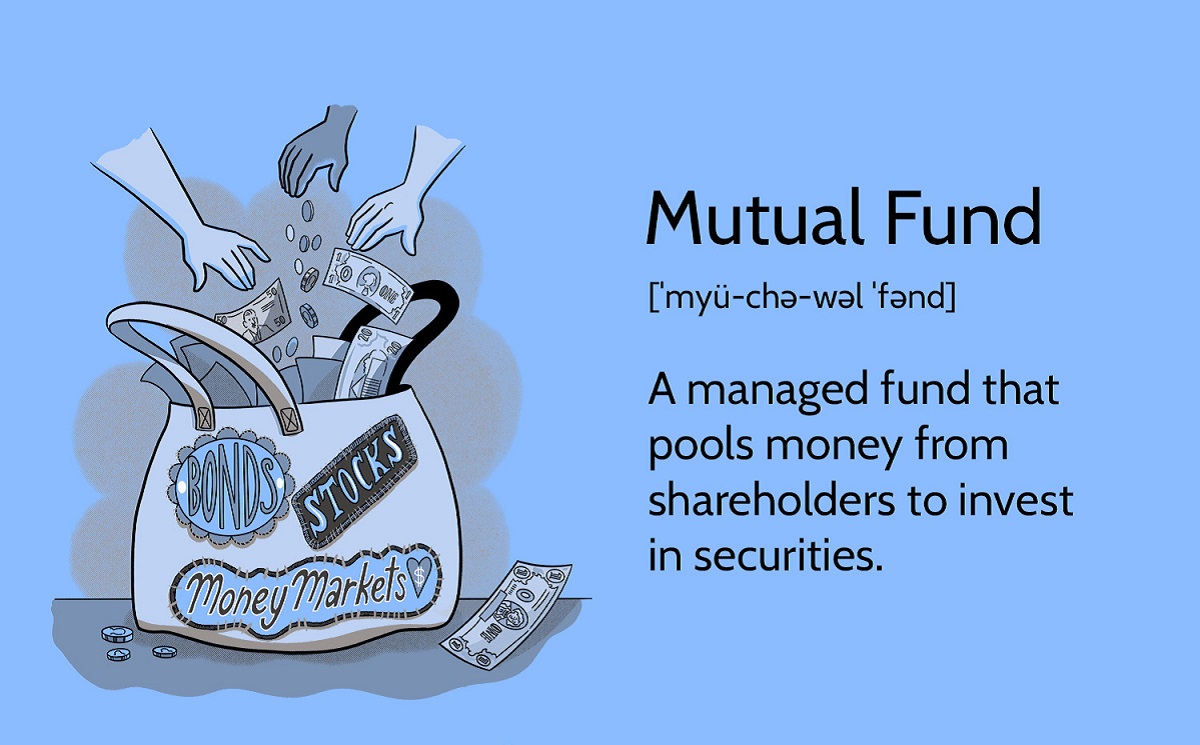Introduction
Welcome to the world of mutual fund investments! Whether you’re a seasoned investor or just starting out, mutual funds can be an excellent addition to your investment portfolio. In this article, we will delve into the fascinating realm of mutual funds, exploring what they are, their advantages, types, how to invest in them, factors to consider before investing, and the risks associated with this investment vehicle.
Mutual funds have gained immense popularity over the years due to their potential for diversification, professional management, and accessibility. By pooling money from various investors, mutual funds provide a way for individuals with limited capital to access a wide range of investment opportunities.
Investing in mutual funds is a popular choice for those who prefer a hands-off approach to investing, as the fund manager makes investment decisions on behalf of the investors. With the potential for higher returns compared to traditional savings accounts, mutual funds offer an attractive investment avenue for individuals looking to grow their wealth over the long term.
Before delving deeper into mutual fund investments, it’s important to note that while mutual funds can offer potential rewards, they also come with risks. As with any investment, it’s crucial to thoroughly understand the risks involved and carefully consider your investment goals and risk tolerance before venturing into mutual funds.
In the following sections, we will explore the world of mutual funds in detail, providing you with the necessary knowledge and insights to make informed investment decisions. So, fasten your seatbelt and get ready to embark on this exciting investment journey!
What Are Mutual Funds?
Mutual funds are investment vehicles that pool money from multiple investors to invest in a diversified portfolio of securities, such as stocks, bonds, and other assets. They are managed by professional fund managers who make investment decisions based on the fund’s objectives and investment strategy.
When you invest in a mutual fund, you are essentially buying units or shares of the fund. The value of each unit, known as the net asset value (NAV), is determined by dividing the total value of the fund’s assets by the number of units outstanding. Mutual funds offer investors an opportunity to participate in the growth potential of a diverse range of investment securities, even with smaller investment amounts.
One of the key advantages of mutual funds is their ability to provide diversification. By investing in a wide variety of securities, mutual funds spread the risk across different asset classes, industries, and companies. This diversification helps reduce the impact of any individual security’s poor performance on the overall fund. It also allows investors to access markets and industries they may not have expertise in or the resources to invest in individually.
Another benefit of mutual funds is the professional expertise of fund managers. These managers have the necessary knowledge, skills, and resources to actively manage the portfolio and make informed investment decisions. They conduct research, analyze market trends, and monitor the performance of individual securities, adjusting the fund’s holdings to optimize returns while managing risk.
Mutual funds also offer liquidity, allowing investors to buy or sell their units on any business day at the current NAV. This liquidity provides flexibility, enabling investors to access their invested capital relatively easily compared to other investment options.
There are various types of mutual funds available to suit different investment goals and risk appetites. These include equity funds, bond funds, balanced funds, sector funds, index funds, and many more. Each type of mutual fund has its own investment objective and strategy, catering to investors’ preferences and financial goals.
In the next section, we will explore the advantages of investing in mutual funds and why they are a popular choice among investors of all levels.
Advantages of Mutual Fund Investments
Investing in mutual funds offers several advantages that make them a preferred choice for many investors. Let’s explore some of the key benefits:
1. Diversification: One of the significant advantages of mutual funds is diversification. By pooling money from numerous investors, mutual funds can invest in a wide variety of securities across different industries and asset classes. This diversification helps spread the risk and reduces the impact of any individual security’s poor performance on the overall portfolio.
2. Professional Management: Mutual funds are managed by experienced and skilled fund managers who have in-depth knowledge of the financial markets. These professionals analyze market trends, conduct research, and make informed investment decisions on behalf of the investors. Their expertise helps in optimizing investment returns and managing risks effectively.
3. Liquidity: Mutual funds offer liquidity, enabling investors to buy or sell their units on any business day at the fund’s net asset value (NAV). This liquidity gives investors the flexibility to access their invested capital when needed, making mutual funds a relatively liquid investment option compared to other investment vehicles.
4. Accessibility: Mutual funds are accessible to a wide range of investors, including both retail and institutional investors. With a lower minimum investment requirement, investors with limited capital can participate in the potential growth of a diversified portfolio. This accessibility makes mutual funds an attractive investment option for individuals looking to start their investment journey.
5. Cost-effectiveness: Mutual funds generally have lower transaction costs and fees compared to individual stock trading. By pooling investors’ money, mutual funds can benefit from economies of scale, reducing costs and making investments more cost-effective for the investors.
6. Regulatory Oversight: Mutual funds are regulated by financial authorities to ensure transparency, investor protection, and compliance with investment guidelines. This regulatory oversight provides investors with a certain level of security and peace of mind.
7. Choice and Flexibility: There is a wide range of mutual fund options available, catering to various investment objectives, risk appetites, and time horizons. Investors can choose from equity funds, bond funds, balanced funds, index funds, sector-specific funds, and more, allowing them to align their investments with their specific financial goals.
These advantages make mutual funds an attractive investment option for both novice and experienced investors. They provide an opportunity to participate in the potential growth of diverse investment portfolios while benefiting from the expertise of professional fund managers.
In the next section, we will delve into the different types of mutual funds available, providing a deeper understanding of the options investors have when investing in mutual funds.
Types of Mutual Funds
Mutual funds come in various types, each with its own investment objective, strategy, and risk profile. Understanding the different types can help investors choose the mutual fund that aligns with their investment goals and risk tolerance. Let’s explore some of the common types of mutual funds:
1. Equity Funds: Equity funds primarily invest in stocks or shares of companies. They aim to provide long-term capital appreciation by investing in companies with growth potential. Equity funds can focus on specific market sectors, geographic regions, or follow a diversified approach.
2. Bond Funds: Bond funds invest in fixed-income securities such as government bonds, corporate bonds, or municipal bonds. These funds aim to generate income for investors through interest payments on the bonds. Bond funds can vary in terms of the credit quality, duration, and type of bonds they hold.
3. Money Market Funds: Money market funds invest in short-term, low-risk instruments such as treasury bills, commercial paper, and certificates of deposit. These funds aim to provide stability and liquidity, making them suitable for investors seeking a safe place to park their cash.
4. Index Funds: Index funds aim to replicate the performance of a specific market index, such as the S&P 500 or the FTSE 100. They passively invest in the same securities that make up the index, providing broad market exposure. Index funds typically have lower expense ratios compared to actively managed funds.
5. Balanced Funds: Balanced funds, also known as asset allocation or hybrid funds, invest in a combination of stocks, bonds, and other securities. They aim to balance capital appreciation and income generation, catering to investors seeking a diversified portfolio with moderate risk.
6. Sector Funds: Sector funds focus on a specific industry or sector, such as technology, healthcare, or energy. These funds provide targeted exposure to a particular sector, allowing investors to capitalize on sector-specific opportunities and trends.
7. Target Date Funds: Target date funds, also known as lifecycle or retirement funds, adjust their asset allocation based on the target retirement date. These funds start with a higher allocation to equities and gradually shift towards fixed-income investments as the target date approaches.
8. Specialty Funds: Specialty funds invest in unique and alternative investment areas, such as real estate, commodities, or socially responsible investments. These funds cater to investors with specific interests or beliefs who want to align their investments accordingly.
It’s important to note that the performance and risk associated with each type of mutual fund can vary. Investors should consider their investment goals, time horizon, and risk appetite when selecting a mutual fund. Additionally, consulting with a financial advisor can provide valuable guidance in choosing the most suitable mutual fund for individual needs.
In the next section, we will explore the process of investing in mutual funds, providing insights into how investors can start their mutual fund journey.
How to Invest in Mutual Funds
Investing in mutual funds is relatively straightforward and accessible to investors of all levels. Here are the steps to follow when considering investing in mutual funds:
1. Set Your Investment Goals: Before investing, define your financial goals, whether it’s saving for retirement, buying a home, or funding your child’s education. Understanding your investment goals will help you choose the right mutual fund that aligns with your objectives.
2. Evaluate Your Risk Tolerance: Assess your risk tolerance, which refers to your willingness and ability to withstand fluctuations in the value of your investment. Determine whether you are comfortable with higher-risk investments for potential higher returns or prefer a more conservative approach with lower-risk investments.
3. Research and Select a Mutual Fund: Conduct thorough research on different mutual funds available in the market. Consider factors such as the fund’s investment objective, past performance, fees and expenses, fund manager experience, and fund size. Choose a fund that matches your investment goals and risk tolerance.
4. Open an Account: To invest in mutual funds, you’ll need to open an account with a reputable fund provider, such as a mutual fund company or an online broker. Fill out the necessary paperwork, provide the required documents, and follow the account opening process as guided by the provider.
5. Investment Amount: Determine the amount you are willing to invest in the mutual fund. Some funds may have minimum investment requirements, so make sure you meet the specified threshold. If you’re starting with a smaller amount, consider investing in mutual funds that allow for smaller initial investments or offer systematic investment plans (SIPs).
6. Choose Your Investment Method: There are different ways to invest in mutual funds. You can opt for lump sum investments, where you invest a one-time amount. Alternatively, you can choose systematic investment plans (SIPs) that allow you to invest a fixed amount at regular intervals, such as monthly or quarterly. SIPs help in rupee-cost averaging and can lower the impact of market volatility.
7. Review and Monitor Your Investments: Once you’ve invested in a mutual fund, regularly review and monitor your investments. Keep track of the fund’s performance, as well as any changes in market conditions or the investment environment. If necessary, make adjustments to your portfolio to ensure it continues to align with your investment goals.
8. Consider Professional Advice: If you’re unsure about the investment process or need personalized guidance, consider seeking the assistance of a financial advisor. They can offer valuable insights and help you make informed decisions based on your specific financial situation and goals.
Remember, investing in mutual funds carries some level of risk, and past performance is not indicative of future results. It’s important to diversify your portfolio, regularly review your investments, and stay informed about market trends and economic developments.
In the next section, we will discuss some important factors to consider before investing in mutual funds, helping you make informed investment decisions.
Factors to Consider Before Investing in Mutual Funds
Before jumping into mutual fund investments, it’s important to consider several factors that can significantly impact your investment journey. Here are some key factors to keep in mind:
1. Investment Objective: Understand your investment objective and choose a mutual fund that matches it. Whether you’re seeking long-term capital appreciation, regular income, or both, selecting a fund aligned with your objective will increase the chances of meeting your financial goals.
2. Risk Tolerance: Assess your risk tolerance and choose mutual funds accordingly. Some funds are more conservative and focus on generating income with lower risk, while others aim for capital appreciation and may carry higher market volatility. Be honest with yourself about how much risk you are willing to take on and select funds that align with your comfort level.
3. Performance Track Record: Evaluate a fund’s historical performance over different market cycles. While past performance doesn’t guarantee future results, it provides insights into a fund’s ability to generate returns and manage risk. Consider funds that have consistently delivered competitive returns relative to their peers and benchmark indices.
4. Fund Expenses: Consider the expenses associated with investing in mutual funds, including management fees, administrative costs, and other charges. These expenses can impact the overall returns on your investment. Compare expense ratios of different funds and choose those that offer a good balance between fees and performance.
5. Asset Allocation: Look into a fund’s asset allocation strategy. Understand the proportion of stocks, bonds, and other securities held in the portfolio. The asset mix should align with your investment goals and risk tolerance. A well-diversified portfolio can help mitigate risk and optimize returns.
6. Fund Manager Expertise: Evaluate the experience and track record of the fund manager. A skilled and knowledgeable fund manager can add value through effective investment strategies and timely decision-making. Look for consistency in a fund manager’s performance and their ability to navigate different market conditions.
7. Investment Style: Consider the investment style of the fund, whether it’s actively managed or passively managed. Active fund managers aim to outperform the market through research and active stock selection, while passive funds track an index and aim to replicate its performance. Choose a style that aligns with your investment philosophy.
8. Exit Strategy: Familiarize yourself with the mutual fund’s exit strategy. Understand the fund’s redemption terms and the time it takes to process withdrawal requests. Consider the liquidity of the fund, especially if you anticipate needing quick access to your investment.
9. Tax Implications: Understand the tax implications of investing in mutual funds. Different types of funds may have different tax treatments. For example, equity funds held for more than one year may qualify for long-term capital gains tax rates. Consult with a tax advisor to understand the tax implications specific to your situation.
10. Regulatory Compliance: Ensure that the mutual funds you are considering are regulated by reputable financial authorities. Look for funds that follow established industry standards and comply with regulatory guidelines. This helps in ensuring transparency, investor protection, and adherence to sound investment practices.
Considering these factors will help you make informed investment decisions and select mutual funds that align with your financial goals, risk tolerance, and investment preferences.
In the next section, we will discuss the potential risks associated with mutual fund investments, helping you become aware of the possible challenges.
Risks Associated with Mutual Fund Investments
While mutual funds offer numerous advantages, it is important to be aware of the potential risks involved. Here are some of the key risks associated with mutual fund investments:
1. Market Risk: Mutual funds are subject to market risk, which means their returns can fluctuate based on changes in market conditions. Factors such as economic developments, interest rate changes, geopolitical events, and investor sentiment can impact the value of the fund’s underlying securities and, consequently, the fund’s performance.
2. Investment Selection Risk: The performance of a mutual fund depends on the investment decisions made by the fund manager. If the manager makes poor investment choices or fails to accurately assess market trends, the fund’s performance may suffer. It is essential to evaluate the track record and expertise of the fund manager before investing.
3. Liquidity Risk: Although mutual funds offer liquidity, there can be instances when it becomes more challenging to buy or sell fund shares. If a significant number of investors try to redeem their shares at the same time, the fund may need to sell securities to meet the redemption requests, potentially causing the fund’s net asset value (NAV) to decline.
4. Concentration Risk: Some mutual funds may have a concentrated portfolio, meaning they have significant exposure to a particular sector, industry, or geographic region. Concentration risk arises when there is a lack of diversification, making the fund more vulnerable to adverse events that impact those specific sectors or regions.
5. Credit Risk: In case the mutual fund invests in bonds or other debt instruments, there is a risk associated with the creditworthiness of the bond issuers. If a bond issuer defaults or faces financial difficulties, it can lead to a decline in the value of the fund’s holdings and negatively affect the performance of the mutual fund.
6. Management Risk: The performance of a mutual fund depends on the skills and expertise of the fund manager. If the manager leaves or is replaced, it can introduce uncertainty and impact the fund’s future performance. It’s important to assess the stability and track record of the fund management team.
7. Regulatory and Political Risk: Mutual funds can be influenced by changes in regulations, tax policies, or political events. For example, government regulations can impact the investments a fund can make or change the tax treatment of certain securities, affecting the fund’s performance.
8. Foreign Exchange Risk: If a mutual fund invests in international securities, currency fluctuations can impact the fund’s returns. Exchange rate movements can positively or negatively affect the value of the fund’s investments denominated in foreign currencies.
It is vital for investors to carefully consider these risks and their individual risk tolerance before investing in mutual funds. Diversification, regular monitoring, and a long-term investment approach can help mitigate some of these risks.
In the next section, we will address some frequently asked questions about mutual funds, providing additional clarity on this investment option.
Frequently Asked Questions (FAQs) about Mutual Funds
Here are some common questions and answers about mutual funds:
1. What is the minimum amount required to invest in a mutual fund?
The minimum investment amount can vary depending on the mutual fund and the investment provider. Some funds may have a minimum requirement of $500 or even less, while others may require a higher initial investment. It’s important to check with the specific fund or provider for their minimum investment criteria.
2. Are mutual funds only for long-term investments?
While mutual funds are often considered suitable for long-term investing, there are also options available for short-term and intermediate-term investment goals. Some funds, like money market funds, are designed for short-term liquidity needs. However, the potential for higher returns is usually associated with longer investment horizons.
3. Can I lose money if I invest in mutual funds?
Yes, investing in mutual funds involves certain risks, including the risk of losing money. This is primarily due to market fluctuations and the performance of the fund’s underlying securities. However, diversification and proper risk management can help mitigate potential losses.
4. Can I invest in multiple mutual funds?
Yes, you can invest in multiple mutual funds to diversify your investment portfolio further. Diversification spreads the risk across different asset classes and reduces the impact of poor performance in any single investment.
5. What fees are associated with investing in mutual funds?
Mutual funds often charge fees such as expense ratios, which cover the fund’s operating expenses, management fees, and administrative costs. There may also be additional fees, such as sales loads (front-end or back-end), redemption fees, or account maintenance fees. It’s important to review the fund’s prospectus to understand the specific fees associated with a particular mutual fund.
6. Can I change or switch mutual funds?
Yes, investors can change or switch their mutual fund investments. This can be done by selling shares of one mutual fund and using the proceeds to purchase shares of another fund. However, it’s important to consider any associated fees or tax implications before making such changes.
7. Are investment returns guaranteed in mutual funds?
No, investment returns in mutual funds are not guaranteed. Mutual funds are subject to market risks, and the value of their investments can fluctuate. The key to achieving returns lies in the fund’s investment strategy, the performance of the underlying securities, and the overall market conditions.
8. Can I invest in mutual funds through a retirement account?
Yes, many retirement account options, such as Individual Retirement Accounts (IRAs) or employer-sponsored plans like 401(k) or 403(b) plans, allow investors to include mutual funds as part of their investment choices. Investing through a retirement account may offer certain tax advantages.
9. Should I consult a financial advisor before investing in mutual funds?
While it’s not mandatory, consulting a financial advisor can provide valuable guidance in choosing the right mutual funds based on your financial goals, risk tolerance, and time horizon. They can also help you navigate through the complexities of mutual fund investing.
10. Are mutual fund investments insured by the government?
Mutual funds are not insured by the government. Unlike bank accounts that benefit from deposit insurance, mutual funds are subject to investment risks and do not carry government-backed protection against losses.
These FAQs aim to address some of the common inquiries related to mutual fund investments. It’s important to conduct thorough research, read the fund’s prospectus, and consult with professionals before making any investment decisions.
In summary, mutual funds offer a range of benefits, from diversification and professional management to liquidity and accessibility. However, it’s crucial to carefully consider the risks, read the fund’s documentation, and align investment choices with individual financial goals and risk tolerance.
Conclusion
Mutual funds provide individuals with the opportunity to invest in a diversified portfolio of securities, managed by professionals, and catered to their specific investment goals. They offer advantages such as diversification, professional management, liquidity, and accessibility, making them a popular choice among investors of all levels.
Before investing in mutual funds, it is important to consider factors such as investment objectives, risk tolerance, performance track record, expenses, and regulatory compliance. Understanding the risks associated with mutual fund investments, including market risk, investment selection risk, and liquidity risk, is crucial in making informed investment decisions.
With various types of mutual funds available, including equity funds, bond funds, balanced funds, and sector funds, investors have the flexibility to choose funds that align with their preferences and financial goals. The process of investing in mutual funds involves setting investment goals, researching and selecting funds, opening an account, determining the investment amount, and monitoring the investments regularly.
While investing in mutual funds offers potential rewards, it is important to remember that investments involve risks, and past performance does not guarantee future results. Regular monitoring, staying informed about market trends, and diversifying the investment portfolio can help mitigate risks.
Ultimately, investing in mutual funds requires careful consideration, thorough research, and a long-term investment mindset. Consulting with a financial advisor can provide valuable guidance tailored to individual needs and circumstances.
By understanding the world of mutual funds and the factors involved in investing, individuals can make informed decisions to grow their wealth and achieve their financial goals.

























